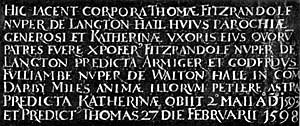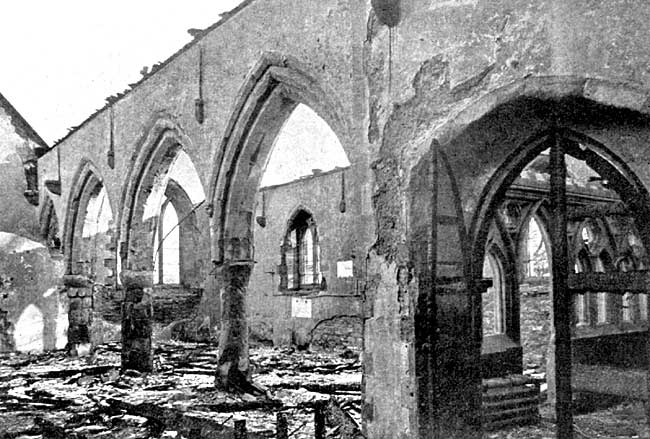From Grimm’s sketches in the British Museum, it appears that in the 15th or 16th century, a clerestory was built over the nave, with plain square-headed mullioned windows and a very flat pitched roof. All the other windows were similar, except the east window, which was rebuilt in the Perpendicular style with a pointed head and traceried lights, filled with stained glass in 1768 by, the then rector, Rev Kaye, afterwards Dean of Lincoln.
About 1863-7 the church was again altered and partly rebuilt. The south aisle was widened, and the western bay separated by a stone traceried screen to form an entrance vestibule, with a wall and doorway between it and the nave, in place of the west arch of the arcade.
The south wall of the chancel was rebuilt with an angle buttress at the south-west corner, some of the old stones having been used, but it seems probable that the wall was not originally in that position, both from the buttress at the angle and also the dwarf buttress (under the east window), which is exactly on the central axial line of the nave and tower, and probably of the original 13th century chancel.
The whole of the windows at this time were built or rebuilt, the east window being left as it was.
The seating was of deal, a carved oak front was put to the organ about 1899, and in 1907 a carved oak reading desk and pulpit were erected.
 The Fitzrandolph brass.
The Fitzrandolph brass.Notwithstanding the fact that so many important families were connected with the parish, no monuments of any note were in the church. The oldest and also the most interesting was a brass, found in the rectory garden and placed on the south wall, to the memory of Thomas Fitzrandolfe and his wife, 1593 and 1598.
A branch of this family, which was probably descended from Fitzranulph, Lord of Alfreton 1130, Sheriff of Notts. and Derby 1165 to 1169, settled at Sutton-in-Ashfield, but removed to Langton Hall, in Kirkby, on the marriage of Christopher Fitzrandolf to Jane Langton, Christopher being buried at Sutton in 1589, though “Torre” gives “Xofer Fitzrandolph” amongst the Rectors obiit 1489 A.D.
Another monument was to William Coke, son and heir to Sir Francis Coke, of Trusley, co. Derby, Knight, who married Maud, eldest daughter of Hen. Beresford, of Alsop, &c., by whom he had issue, four sons and four daughters, he being of the age of 47, March 27th, 1641, and another stone to his wife, Maud, and two of their children, Isbel and Henry. A drawing of these stones has been inserted in the first volume of the parish registers.
William, a younger son of John Sacheverell, by the co-heiress of Leche, married the daughter and heiress of Snitterton, and was of Ible and Snitterton. Thomas, his grandson, sold Ible in 1498. Thomas, son of Thomas, was living at Kirkby in 1574, which had been acquired with the heiress of Kirkby, he had an only son and heir, married to Coke, of Trusley, and this important family still resides at Brookhill Hall, and owns Kirkby Old Hall and considerable property in the parish.
The rectory, one of the most valuable, has been occupied by many prominent men who played considerable parts in the parish history. The saintly Clement Ellis, who died in 1700; Matthew Brailsford, S.T.P., who was also Dean of Wells; Sir Richard Kaye, Bart., 1765, who presented the communion plate; the Rev. Brooke Boothby, son of Sir William Boothby, 1811; the Rev. the Hon. John V. Vernon, 1829, and the Rev. Thomas Woodman. It is now held by the Rev. James Butterwick.

Interior of Kirkby-in-Ashfield church after the disastrous fire of 1907.
The church was utterly destroyed by the act of an incendiary in the night of the 16th and 17th January, 1907, and is now being rebuilt, Mr. Louis Ambler, of Temple Avenue, London, being the architect, and to him I am indebted for the architectural notes. An interesting monograph has also been published by the rector, to which the reader is referred.
